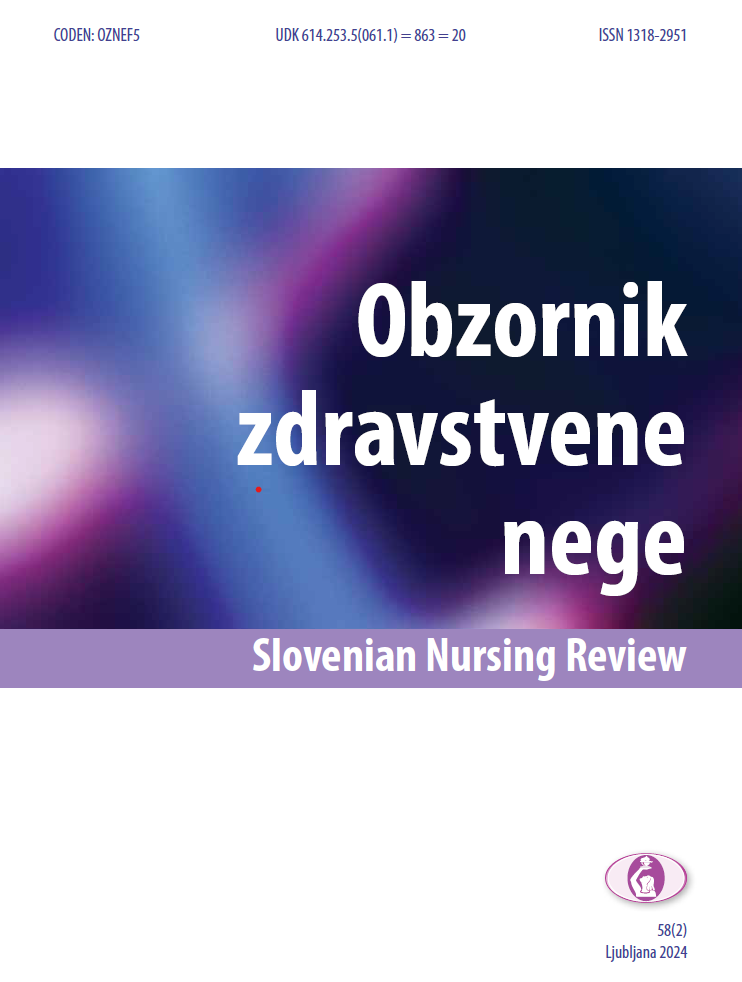Vpliv porodnega položaja pri iztisu ploda na poškodbo presredka
DOI:
https://doi.org/10.14528/snr.2024.58.2.3213Ključne besede:
porod, varovanje presredka, epiziotomija, poškodbe tretje in četrte stopnjePovzetek
Uvod: Vpliv porodnega položaja na tveganje za poškodbo presredka, ki je odvisen od lokalnih in regionalnih babiških praks, kot so ročna tehnika zaščite presredka, razne stopnje epiziotomije in operativnih porodov itd., še ni zadostno raziskan. Namen raziskave je bil v eni od slovenskih porodnišnic preučiti morebitno povezavo med porodnim položajem ob iztisu ploda in pojavnostjo poškodbe presredka.
Metode: V retrospektivno kohortno raziskavo smo vključili 625 porodnic, ki so leta 2021 rodile v Splošni bolnišnici Jesenice. Izključili smo večplodne nosečnosti, prezgodnje porode, porode s plodom v medenični ali okcipito-posteriorni vstavi, vakuumske ekstrakcije ploda in epiziotomije. Z multiplo logistično regresijo smo preučili, ali je bil položaj porodnice ob iztisu ploda (leže na hrbtu (n = 66), leže na boku (n = 404) ali vsi ostali položaji (n = 155)) neodvisno povezan s pojavnostjo poškodbe presredka.
Rezultati:Pri 363 porodnicah (58 %) ni prišlo do poškodbe presredka. Pri 192 (73 %) je prišlo do poškodbe prve stopnje, pri 59 (23 %) do poškodbe druge stopnje in pri 11 (4 %) do poškodbe presredka tretje ali četrte stopnje. Porodni položaj ob iztisu ploda ob upoštevanju drugih potencialnih dejavnikov tveganja ni bil statistično pomembno povezan s tveganjem za poškodbo presredka: razmerje obetov (RO) 0,691, 95% interval zaupanja (IZ) – 0,401–1,191 za položaj na boku; RO 0,710, 95% IZ – 0,386–1,306 za ostale položaje v primerjavi s porajanjem leže na hrbtu.
Diskusija in zaključek: V slovenski porodnišnici z visokim odstotkom porodnic, ki ne rodijo leže na hrbtu, porodni položaj ob iztisu ploda ni neodvisni dejavnik tveganja za nastanek poškodbe presredka
Prenosi
Metrike
Literatura
Declercq, E. R., Sakala, C., Corry, M. P., Applebaum, S., & Herrlich, A. (2014). Major survey findings of listening to mothers (SM) III: Pregnancy and Birth: Report of the third National U.S. survey of women's childbearing experiences. The Journal of Perinatal Education, 23(1), 9–16. https://doi.org/10.1891/1058-1243.23.1.9 PMid:24453463; PMCid:PMC3894594
Gupta, J. K., Sood, A., Hofmeyr, G. J., & Vogel, J. P. (2017). Position in the second stage of labour for women without epidural anaesthesia. The Cochrane Database of Systematic Reviews, 5(5), CD002006. https://doi.org/10.1002/14651858.CD002006.pub4 PMid:28539008
Jansson, M. H., Franzén, K., Hiyoshi, A., Tegerstedt, G., Dahlgren, H., & Nilsson, K. (2020). Risk factors for perineal and vaginal tears in primiparous women: The prospective POPRACT-cohort study. BMC Pregnancy and Childbirth, 20(1), Article 749. https://doi.org/10.1186/s12884-020-03447-0 PMid:33267813; PMCid:PMC7709229
Pergialiotis, V., Vlachos, D., Protopapas, A., Pappa, K., & Vlachos, G. (2014). Risk factors for severe perineal lacerations during childbirth. International Journal of Gynaecology and Obstetrics, 125(1), 6–14. https://doi.org/10.1016/j.ijgo.2013.09.034 PMid:24529800
Purnama, Y., Mose, J. C., & Herman, H. (2018). The effect of the BC-MK15 birth chair on the labor pain intensity in multipara. Global Medical and Health Communication 6(3), 155-161. https://doi.org/10.29313/gmhc.v6i3.2841
Royal College of Obstetricians and Gynaecologists. (2015). The Management of third- and fourth-degree perineal tears. Greentop Guideline No 29. https://www.rcog.org.uk/media/5jeb5hzu/gtg-29.pdf
Serati, M., Di Dedda, M. C., Bogani, G., Sorice, P., Cromi, A., Uccella, S., Lapenna, M., Soligo, M., & Ghezzi, F. (2016). Position in the second stage of labour and de novo onset of post-partum urinary incontinence. International Urogynecology Journal, 27(2), 281–286. https://doi.org/10.1007/s00192-015-2829-z PMid:26337426
Simarro, M., Espinosa, J. A., Salinas, C., Ojea, R., Salvadores, P., Walker, C., & Schneider, J. (2017). A prospective randomized trial of postural changes vs passive supine lying during the second stage of labor under epidural analgesia. Medical Sciences, 5(1), Article 5. https://doi.org/10.3390/medsci5010005 PMid:29099021; PMCid:PMC5635775
Slovensko zdravniško društvo & Zdravniška zbornica Slovenije. (2016). Kodeks zdravniške etike. Zdravniški vestnik, 86(1/2), Article 76. https://doi.org/10.6016/ZdravVestn.2498
Smith, L. A., Price, N., Simonite, V., & Burns, E. E. (2013). Incidence of and risk factors for perineal trauma: A prospective observational study. BMC Pregnancy and Childbirth, 13, Article 59. https://doi.org/10.1186/1471-2393-13-59 PMid:23497085; PMCid:PMC3599825
Sultan, A. H. (1999). Obstetric perineal injury and anal incontinence. Clinical Risk, 5(6), 193–196. https://doi.org/10.1177/135626229900500601
Thies-Lagergren, L., Hildingsson, I., Christensson, K., & Kvist, L. J. (2013). Who decides the position for birth: A follow-up study of a randomised controlled trial. Women and Birth, 26(4), e99–e104. https://doi.org/10.1016/j.wombi.2013.06.004 PMid:23932671
Zhang, H., Huang, S., Guo, X., Zhao, N., Lu, Y., Chen, M., Li, Y., Wu, J., Huang, L., Ma, F., Yang, Y., Zhang, X., Zhou, X., Guo, R., & Cai, W. (2017). A randomised controlled trial in comparing maternal and neonatal outcomes between hands-and-knees delivery position and supine position in China. Midwifery, 50, 117–124. https://doi.org/10.1016/j.midw.2017.03.022 PMid:28414983
Zang, Y., Lu, H., Zhao, Y., Huang, J., Ren, L., & Li, X. (2020). Effects of flexible sacrum positions during the second stage of labour on maternal and neonatal outcomes: A systematic review and metaanalysis. Journal of Clinical Nursing, 29(17/18), 3154–3169. https://doi.org/10.1111/jocn.15376 PMid:32531856
Kodeks etike v zdravstveni negi in oskrbi Slovenije in Kodeks etike za babice Slovenije. (2014). Ljubljana: Zbornica zdravstvene in babiške nege Slovenije – Zveza strokovnih društev medicinskih sester, babic in zdravstvenih tehnikov Slovenije.
World Medical Association. (2013). World Medical Association Declaration of Helsinki: Ethical principles for medical research involving human subjects. Journal of the American Medical Association, 310(20), 2191–2194. https://doi.org/10.1001/jama.2013.281053 PMid:24141714
Prenosi
Objavljeno
Kako citirati
Številka
Rubrike
Licenca
Avtorske pravice (c) 2024 Obzornik zdravstvene nege

To delo je licencirano pod Creative Commons Priznanje avtorstva 4.0 mednarodno licenco.
Na Obzornik zdravstvene nege, Ob železnici 30A, 1000 Ljubljana, prenašam naslednje materialne avtorske pravice: pravico reproduciranja v neomejeni količini, in sicer v vseh poznanih oblikah reproduciranja, kar obsega tudi pravico shranitve in reproduciranja v kakršnikoli elektronski obliki (23. čl. Zakona o avtorski in sorodnih pravicah – v nadaljevanju ZASP); pravico distribuiranja (24. čl. ZASP); pravico dajanja na voljo javnosti vključno z dajanjem na voljo javnosti prek svetovnega spleta oz. računalniške mreže (32.a čl. ZASP); pravico predelave, zlasti za namen prevoda (33. čl. ZASP). Prenos pravic velja za članek v celoti (vključno s slikami, razpredelnicami in morebitnimi prilogami). Prenos je izključen ter prostorsko in časovno neomejen.
























